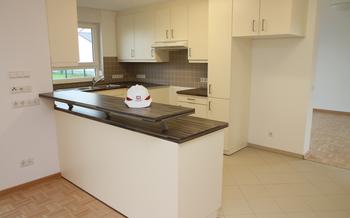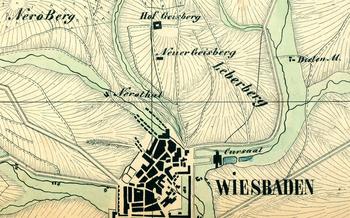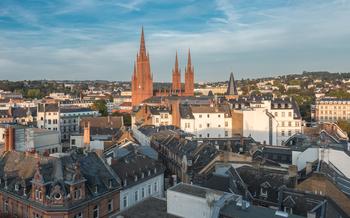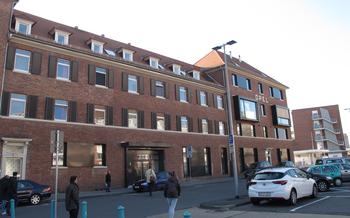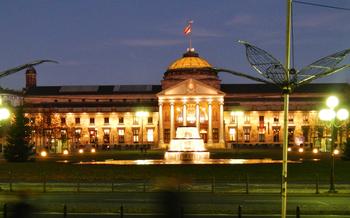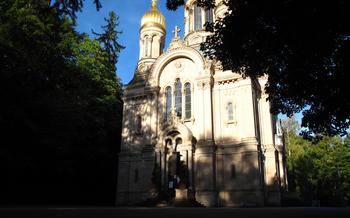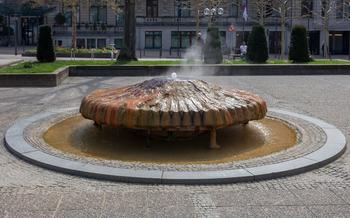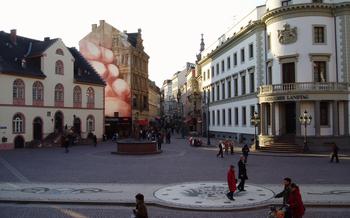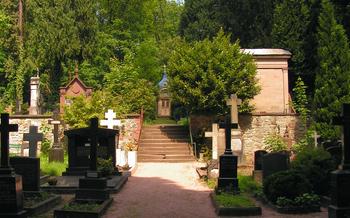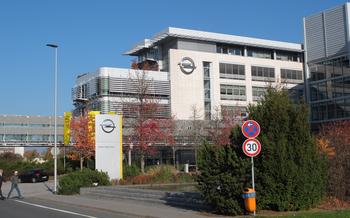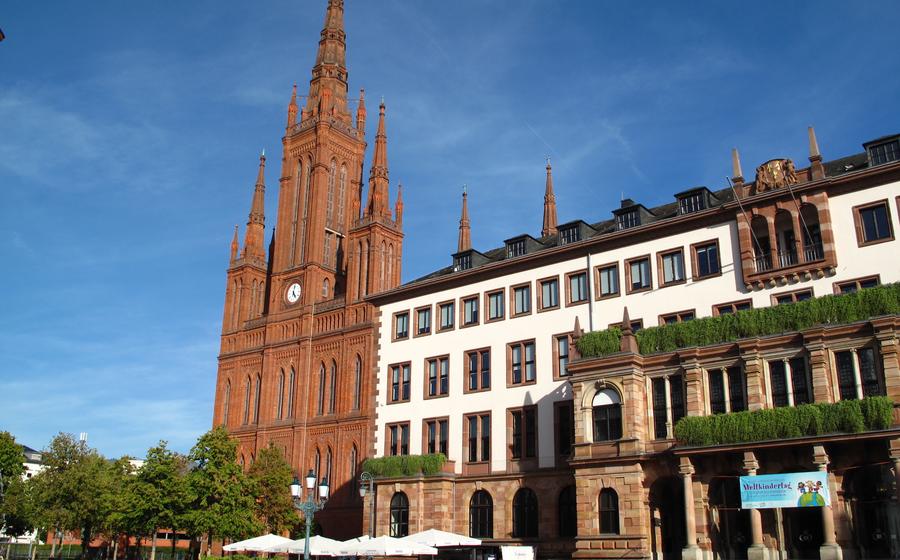
The Michelsberg Settlement
- Historical Background
- Archeological Discoveries
- Thermal Springs
- Roman Bath Ruins
- Museum Wiesbaden: A Treasure Trove of Roman Artifacts
- Kurpark: A Tranquil Oasis in the Heart of Wiesbaden
- Casino Wiesbaden: A Legacy of Elegance and Excitement
- Biebricher Schloss
- Rheingau Wine Region
- Rheinsteig Hiking Trail
- Day Trip to Mainz
- Insider Tip: Kurhaus Wiesbaden
Historical Background
In the heart of Germany, Wiesbaden boasts a rich historical tapestry that dates back to the ancient Roman era. The city's origins can be traced to the Roman settlement of Aquae Mattiacorum, established around the 1st century AD. The strategic importance of this area stemmed from its abundance of hot springs, which were believed to possess healing properties. The Romans, recognizing the therapeutic value of these springs, constructed a military base and developed the settlement into a flourishing provincial capital. As a testament to its significance, Wiesbaden served as the administrative center of the Roman province of Germania Superior.
Archeological Discoveries
Significant Roman artifacts unearthed in Wiesbaden have painted a vivid picture of ancient life in the city. The excavation process involved meticulous exploration of the buried ruins, revealing a treasure trove of artifacts that shed light on the city's rich past. Among these discoveries, the Roman bath complex stands out as a testament to the city's significance as a provincial capital. The baths, with their intricate mosaics and well-preserved structures, offer a tangible connection to the daily lives of the Roman inhabitants. Ongoing research and preservation efforts at the site ensure that these priceless artifacts continue to be protected and studied for generations to come.
Thermal Springs
Wiesbaden's thermal springs have been a source of healing and rejuvenation for centuries. The city's unique geological location, situated on the Rhine Rift Valley, allows for the rise of hot water from deep within the earth's crust. These springs are rich in minerals, such as sodium, chloride, and fluoride, which are believed to have therapeutic properties.
The healing powers of Wiesbaden's thermal waters were recognized as early as Roman times. The Romans built elaborate bath complexes, known as thermae, to harness the benefits of these natural hot springs. Today, Wiesbaden's thermal springs continue to attract visitors from around the world seeking relief from various ailments, including rheumatism, arthritis, and skin conditions.
In addition to their therapeutic properties, Wiesbaden's thermal springs also play a significant role in the city's cultural and social life. The hot springs have been a popular gathering place for centuries, and the city's many spas and bathhouses offer a variety of bathing rituals and treatments. Visitors can indulge in a relaxing soak in the thermal waters, enjoy a massage or beauty treatment, or simply unwind in the tranquil atmosphere of a spa.
Roman Bath Ruins
In the heart of Wiesbaden, amidst the bustling modern city, lie the remarkably preserved ruins of a Roman bathhouse, a testament to the city's ancient past. Step through the gates and be transported back in time to a world of thermal indulgence and social interaction.
The bath complex, known as the Römerbad, dates back to the 1st century AD and served as a vital part of Roman life. As you wander through the ruins, you'll encounter various sections that once played distinct roles in the bathing ritual.
The caldarium, or hot bath, was the centerpiece of the complex. Its well-preserved hypocaust system, a clever underfloor heating mechanism, ensured a constant supply of steam and warmth. Imagine sinking into the hot pools, letting your muscles relax and your worries melt away.
Adjacent to the caldarium was the tepidarium, a warm bath that served as a transition between the hot and cold baths. Here, bathers could gradually acclimatize their bodies to the changing temperatures.
The frigidarium, or cold bath, provided a refreshing contrast to the hot and warm baths. Its icy plunge pool was believed to have invigorating and therapeutic effects, stimulating circulation and revitalizing the senses.
Beyond the bathing areas, the bathhouse also featured various social spaces. The palaestra, a large open courtyard, was used for exercise and sports activities. Here, Romans could engage in wrestling, weightlifting, and other physical pursuits.
The apodyterium, or changing room, was where bathers prepared for their bathing rituals. Rows of stone benches and niches provided space for them to store their clothes and belongings.
As you explore the ruins, take a moment to appreciate the architectural features and engineering marvels that made this bathhouse so remarkable. The intricate mosaic floors, the vaulted ceilings, and the ingenious plumbing system showcase the advanced construction techniques of the Romans.
The Römerbad was not merely a place for bathing; it was a social and cultural hub where Romans from all walks of life gathered to relax, socialize, and rejuvenate. It was a place where politics were discussed, business deals were struck, and friendships were forged.
Today, the Roman bath ruins stand as a testament to Wiesbaden's rich history and its enduring connection to its ancient roots. They offer a glimpse into the daily lives of the Romans and remind us of the enduring power of water and its ability to heal, cleanse, and connect.
Museum Wiesbaden: A Treasure Trove of Roman Artifacts
Museum Wiesbaden stands as a testament to the city's rich Roman history, housing an extensive collection of artifacts that provide a glimpse into the daily lives and culture of the ancient Roman settlers. Among the museum's highlights are exquisite Roman sculptures, intricate mosaics, and finely crafted pottery, each piece narrating a chapter in Wiesbaden's past.
Roman Sculptures: The museum's collection of Roman sculptures is particularly noteworthy, featuring life-size statues of gods, emperors, and ordinary citizens. These sculptures offer a glimpse into the artistic prowess of the Roman artisans and provide valuable insights into the religious beliefs, political structures, and social customs of the time.
Mosaics: The museum's collection of Roman mosaics is equally impressive, showcasing intricate designs and vibrant colors that have stood the test of time. These mosaics once adorned the floors of Roman villas and public buildings, adding a touch of elegance and luxury to everyday life.
Pottery: The museum's vast collection of Roman pottery offers a glimpse into the domestic lives of the ancient Romans. From simple cooking utensils to elaborately decorated vases, these artifacts provide insights into the culinary practices, trade networks, and artistic traditions of the Roman era.
Interactive Exhibits and Educational Programs: Museum Wiesbaden goes beyond simply displaying artifacts; it also offers interactive exhibits and educational programs that bring the Roman past to life. Visitors can engage with hands-on activities, view informative films, and participate in workshops that delve deeper into the history and culture of Roman Wiesbaden.
A Must-Visit for History Enthusiasts: A visit to Museum Wiesbaden is a must for anyone interested in Roman history and archaeology. The museum's extensive collection, interactive exhibits, and educational programs provide a comprehensive and engaging exploration of Wiesbaden's Roman roots.
Kurpark: A Tranquil Oasis in the Heart of Wiesbaden
In the heart of Wiesbaden, nestled amidst the bustling city streets, lies the Kurpark, a sprawling park that offers a serene escape from the urban hustle and bustle. This verdant sanctuary, steeped in history and natural beauty, is a beloved destination for locals and visitors alike.
Strolling through the park's meticulously manicured gardens, visitors are greeted by a symphony of colors and fragrances. Vibrant flowerbeds burst with an array of hues, while the heady scent of roses fills the air. Lush green lawns invite visitors to relax and unwind, while majestic trees provide shade and shelter from the summer sun.
The Kurpark is not just a place for passive relaxation; it also offers a variety of attractions that cater to diverse interests. The colonnade, with its elegant arches and intricate carvings, provides a picturesque backdrop for leisurely walks or romantic strolls. The bandstand hosts regular concerts and performances, filling the air with melodious tunes that add to the park's charm.
For those seeking a touch of excitement, the Kurpark is home to a casino, where visitors can try their luck at roulette, blackjack, or poker. The casino's opulent interior and lively atmosphere make it a popular destination for thrill-seekers and those looking for a night of entertainment.
Whether you're seeking tranquility, recreation, or a taste of Wiesbaden's cultural offerings, the Kurpark has something for everyone. Take a leisurely stroll, enjoy a picnic on the lush lawns, or immerse yourself in the park's rich history and attractions. The Kurpark is a must-visit destination that will leave you feeling refreshed, rejuvenated, and inspired.
Casino Wiesbaden: A Legacy of Elegance and Excitement
Nestled in the heart of Wiesbaden, Casino Wiesbaden stands as a testament to the city's rich history and vibrant cultural scene. Founded in 1771, it is one of Germany's oldest and most prestigious casinos, attracting visitors from around the world with its opulent ambiance and thrilling gaming experiences.
The casino's striking exterior, with its grand entrance and elegant façade, hints at the glamour that awaits within. Step inside, and you'll be transported to a world of sophistication and excitement. The casino's spacious gaming rooms are adorned with intricate chandeliers, plush carpets, and polished wood paneling, creating an atmosphere of luxury and exclusivity.
Casino Wiesbaden offers a diverse range of games to suit every taste and preference. Whether you're a seasoned gambler or a novice trying your luck for the first time, you'll find something to keep you entertained. From classic table games like roulette, blackjack, and poker to a variety of slot machines, the casino has it all.
The casino also boasts a dedicated poker room, where players can engage in friendly competition or participate in exciting tournaments. With its comfortable seating, professional dealers, and lively atmosphere, the poker room is a popular destination for both experienced players and those looking to learn the ropes.
Beyond gaming, Casino Wiesbaden offers a range of other attractions to enhance your visit. The casino's elegant restaurant serves delicious cuisine, accompanied by live music and stunning views of the city. For those seeking a more relaxed experience, the casino's bar offers a variety of drinks and snacks, as well as live entertainment on select nights.
Casino Wiesbaden is more than just a gaming destination; it's a place where history, culture, and entertainment converge. Its rich legacy, combined with its modern amenities and diverse offerings, ensures that it remains one of Germany's most beloved casinos. Whether you're a seasoned gambler, a casual visitor, or simply looking for a unique and memorable experience, Casino Wiesbaden is sure to leave a lasting impression.
Biebricher Schloss
Biebricher Schloss is a magnificent palace located in the Biebrich district of Wiesbaden. Built in the 17th century as a summer residence for the Dukes of Nassau, the palace is a splendid example of Baroque architecture. The palace's grand façade is adorned with intricate carvings, statues, and a large clock tower. The interior of the palace is equally impressive, with opulent rooms decorated with fine furniture, paintings, and tapestries.
The palace's beautiful gardens are a sight to behold. Laid out in the French formal style, the gardens feature manicured lawns, colorful flowerbeds, and towering trees. The gardens also boast several fountains, sculptures, and a picturesque pond.
Today, Biebricher Schloss serves as a museum and event venue. Visitors can explore the palace's grand halls and admire its impressive collection of art and furniture. The palace also hosts a variety of events throughout the year, including concerts, exhibitions, and weddings.
For a glimpse into the lavish lifestyle of the Dukes of Nassau, a visit to Biebricher Schloss is a must. The palace's grandeur, beautiful gardens, and rich history make it a popular destination for both locals and tourists alike.
Rheingau Wine Region
The Rheingau is a renowned wine-growing region located just west of Wiesbaden. Blessed with a favorable climate and fertile soil, the region produces some of Germany's finest wines. The Rheingau is particularly famous for its Riesling grapes, which thrive in the region's unique terroir.
Strolling through the picturesque vineyards, you'll be greeted by rolling hills covered in lush vines, interspersed with charming villages and historic castles. The region's mild climate and abundant sunshine create ideal conditions for the grapes to ripen, resulting in elegant and well-balanced wines.
A visit to the Rheingau is a must for any wine enthusiast. Take a leisurely drive along the scenic Rheingau Wine Route, stopping at various wineries to sample their offerings. Visit the Rheingau Vinothek in Wiesbaden to taste a wide selection of regional wines. You can also join a guided wine tour to learn more about the region's viticulture and history.
Whether you're a seasoned wine connoisseur or simply looking to experience the charm of the German countryside, the Rheingau is sure to delight your senses. Immerse yourself in the region's wine culture, savor the flavors of its exceptional wines, and create memories that will last a lifetime.
Rheinsteig Hiking Trail
The Rheinsteig Hiking Trail is a scenic and challenging long-distance path that stretches for approximately 320 kilometers along the eastern bank of the Rhine River, from Wiesbaden to Bonn. It offers breathtaking views of the river, vineyards, and castles, making it a popular destination for hikers and nature enthusiasts.
The trail is divided into 23 stages, each ranging from 10 to 25 kilometers in length, and can be hiked individually or as a whole. It passes through a variety of landscapes, including forests, vineyards, and riverbanks, and offers hikers the opportunity to experience the natural beauty of the Rhine Valley up close.
The Rheinsteig is well-marked and maintained, with clear signage and regular rest stops along the way. It also caters to hikers of all abilities, with varying difficulty levels ranging from easy to challenging. Whether you're a seasoned hiker looking for a physical challenge or a casual walker seeking a scenic stroll, there's a section of the Rheinsteig that's perfect for you.
For those interested in exploring the Rheinsteig, it's recommended to plan your hike in advance, considering the length of the trail and the difficulty level of each stage. Proper hiking gear and comfortable shoes are essential, as well as sufficient food and water supplies. Accommodation options are available along the trail, ranging from guesthouses and hotels to campsites.
Hiking the Rheinsteig is an unforgettable experience that allows you to immerse yourself in the beauty of the Rhine Valley, discover its rich history and culture, and challenge yourself physically. Whether you choose to hike the entire trail or just a section of it, the Rheinsteig offers a unique and rewarding adventure for hikers of all levels.
Day Trip to Mainz
Just a short train ride away from Wiesbaden lies the charming city of Mainz, the capital of Rhineland-Palatinate. Steeped in history and culture, Mainz offers a wealth of attractions for visitors to explore.
Start your day with a visit to the Gutenberg Museum, dedicated to the life and work of Johannes Gutenberg, the inventor of the printing press. Here, you can learn about the revolutionary impact of Gutenberg's invention on the spread of knowledge and culture.
Next, make your way to the Mainz Cathedral, an impressive example of Romanesque architecture. Admire its soaring spires and intricate carvings, and take a moment to step inside to experience its serene atmosphere.
For a glimpse into Mainz's Roman past, visit the Roman Theater, one of the best-preserved Roman theaters north of the Alps. Imagine gladiators battling in the arena or actors performing ancient plays on this very stage.
Mainz is also renowned for its culinary scene. Indulge in a traditional German meal at one of the many restaurants in the city center, or sample the local wines at a cozy wine bar.
With its rich history, cultural attractions, and culinary delights, Mainz is the perfect destination for a day trip from Wiesbaden. Immerse yourself in the city's vibrant atmosphere and discover its many hidden treasures.
Insider Tip: Kurhaus Wiesbaden
Stroll down Wiesbaden's elegant Wilhelmstrasse and discover a hidden gem nestled amidst the city's grandeur: the Kurhaus Wiesbaden. This magnificent building, constructed in the 19th century, boasts a captivating blend of architectural styles, from Neoclassical to Art Nouveau. Step inside and immerse yourself in an atmosphere of opulence and history.
The Kurhaus is more than just a building; it's a symbol of Wiesbaden's cultural heritage. Within its walls, you'll find a concert hall that hosts world-renowned orchestras and performers, an art gallery showcasing exquisite exhibitions, and a casino that exudes an air of excitement and intrigue.
Take a moment to admire the Kurhaus's stunning architecture. The grand ballroom, with its intricate chandeliers and ornate ceiling frescoes, is a masterpiece of design. Wander through the colonnaded courtyard, where you can soak in the tranquil ambiance and enjoy a refreshing drink or a delicious meal.
The Kurhaus also offers a range of culinary delights. From fine dining at the Michelin-starred restaurant to casual bites at the café, there's something to satisfy every palate. Indulge in a culinary journey that showcases the flavors of the region, accompanied by a glass of exquisite wine from the nearby Rheingau wine region.
Whether you're a history buff, an art enthusiast, or simply seeking a unique experience, the Kurhaus Wiesbaden is a must-visit destination. Allow yourself to be captivated by its charm, immerse yourself in its cultural offerings, and create memories that will last a lifetime.
